One subject that has often been overlooked, is the genetic influence of the first megalith builders of Northern France. This location is meeting point between Danubian and Cardial Neolithic groups. Not only that, but also mixture with Mesolithic hunters of the region. This mixture can be seen quite clearly in the mtDNA (Rivollat et al, 2015; LeRoy et al, 2016). The one thing that is also questioned is just how much genetic impact did Megalithism have on the genetic make-up of Northern European farmers of the Middle and Late Neolithic. Is this a movement of people, or “monumental” ideas?

Since early times, the movement of farmers to Britain was seen as a movement from France, from Michelsberg, or related groups (Childe, 1931). To test this idea, I used datasets from Lipson et al, 2017; Olalde et al, 2018; and Mathieson et al, 2018) to look for a relationship using qpGraph.
Not only are the samples from Southern France and England alike, they are basically identical! Both are probably rooted in the Paris Basin, showing Danubian, Cardial, and Mesolithic roots. As the link is shown below, in Le Roy et al (2016). Also, note the shift towards France, by later Central Farmers of the Middle to Late Neolithic.







Below, is the first graph, showing the genetic ties between England, and Southern France. Both are likely from the Paris Basin group.
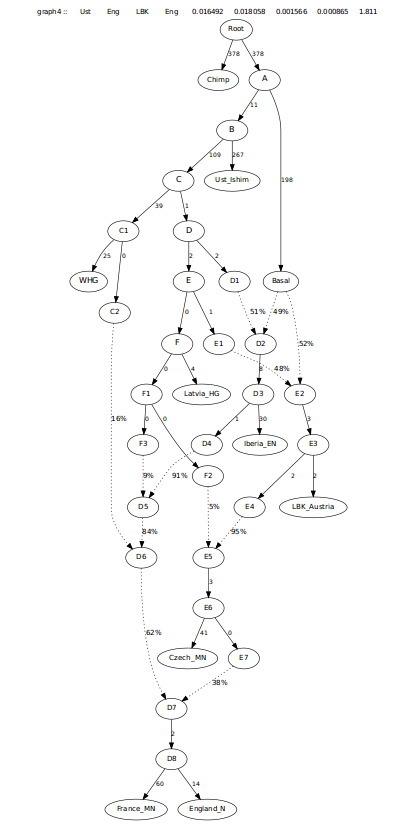
D-stats showing France_MN and England_N as a clade
| Out | Test | X | Y | D | Z-score | SNPs |
| Chimp | Ust_Ishim | France_MN | England_N | -0.000325 | -1.052 | 890030 |
| Chimp | WHG | France_MN | England_N | 0.000041 | 0.116 | 888629 |
| Chimp | Iberia_EN | France_MN | England_N | -0.000248 | -0.923 | 860108 |
| Chimp | LBKAustria | France_MN | England_N | -0.000119 | -0.469 | 887340 |
| Chimp | GermanMN | France_MN | England_N | 0.000152 | 0.514 | 853634 |
| Chimp | Gokhem2 | France_MN | England_N | -0.00022 | -0.437 | 209487 |
| Chimp | MN_Iberia | France_MN | England_N | -0.000539 | -1.933 | 830076 |
| Chimp | GAC_Poland | France_MN | England_N | 0.000002 | 0.007 | 694973 |
| Chimp | Czech_MN | France_MN | England_N | -0.000167 | -0.558 | 818848 |
Graph with England_N alone

German Middle Neolithic Funnelbeaker
This same set-up is the one I used to then find the relationship to later Megalith building cultures. The first one I chose to look at was the Funnelbeaker samples from Germany. The surprising thing from this graph is that the German Middle Neolithic samples (minus the Roessen sample) were almost exactly like the England and French Neolithic samples, with a slight bit more Danubian admixture.
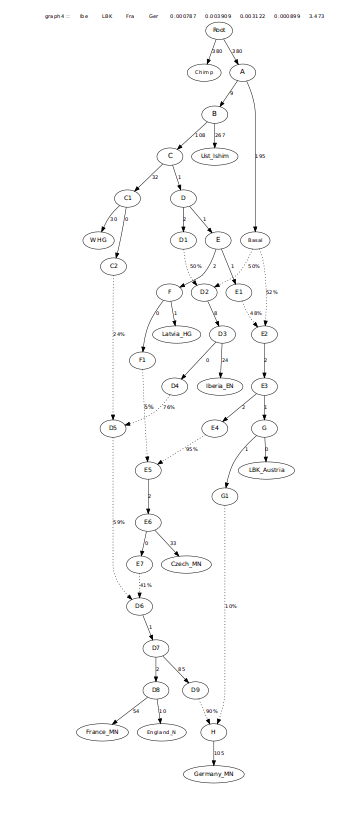
Attempt to create TRB-Germany without admixture from French-related groups
The first graph, is just Germany_MN, uplaced, with the worst-Z being one that asks for Germany_MN and England_N to be closer.

The second graph forces Germany_MN to be attached to LBK
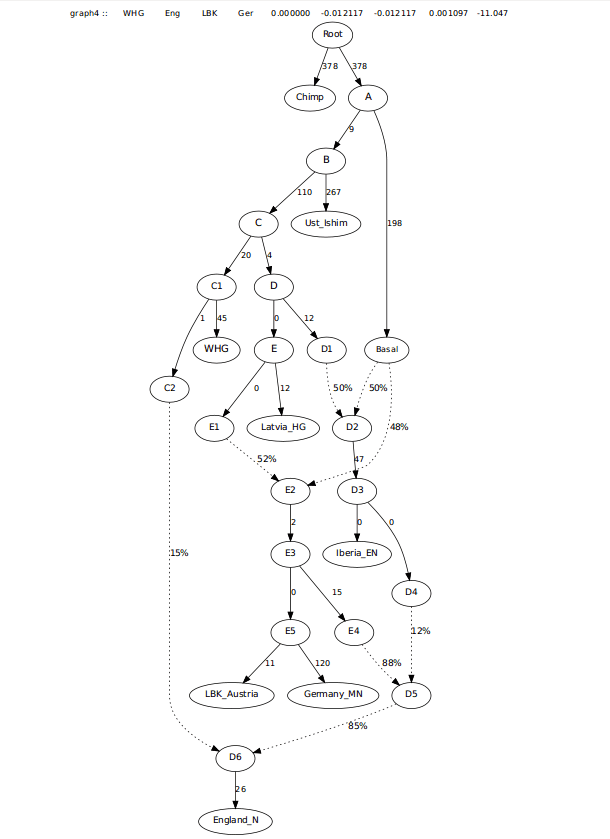
The worst-Z from this graph asks for WHG to be closer to Germany_MN. The following graph includes an edge from WHG to Germany_MN.

As a result of this graph, the worst-Z now asks for Germany_MN and Iberia_EN to be closer. Due to this, a migration edge from Iberia_EN is added to the next graph.

This last graph has many issues. Not only the zero drift edges, but a migration edge of 0% from Iberia to Germany and a worst-Z still not resolved. It seems that deviating from the desire to connect Germany_MN and England_N caused the poor outcome.
Iberian Middle Neolithic at La Mina
The second group that I looked at was the Middle Neolithic group from La Mina, in Northern Spain. Once again, the Middle Neolithic population was almost identical to the group with roots in France. Specifically, those that moved to Southern France.
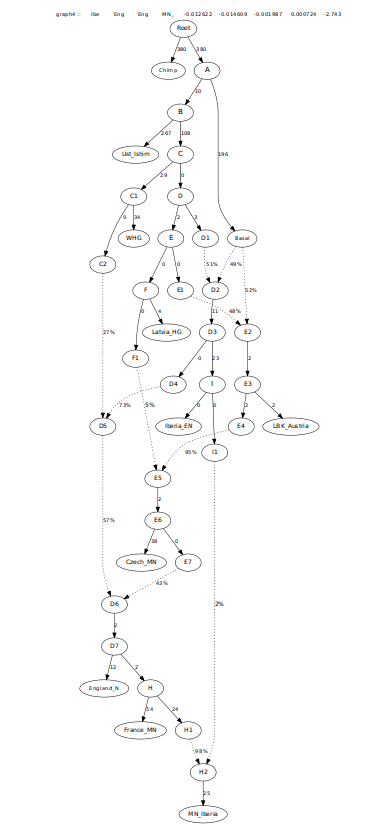
Swedish Funnelbeaker
While Gokhem2 does not have as much coverage as I would like, I thought that they would also be good to check, to make sure they are also rooted in the same group. As suspected, she was also almost exactly like the English and French samples.

Globular Amphora in Poland
Since Globular Amphora is supposed to come out of the TRB group in Northern Germany, I thought that I would also take a look at them and see if they are also closely related to the farmers from France. They also turned out to have a great deal of their ancestry from this group.

So, the picture that is emerging is that at one time, groups from Iberia, to Britain, up to Scandinavia, and all the way to the steppes of Ukraine were rooted in the French Middle Neolithic.
D-stats suggestive of Cardial gene-flow
| Out | Test | X | Y | D | Z-score | SNPs |
| Chimp | England_N | Iberia_EN | LBKAustria | -0.00065 | -3.053 | 922319 |
| Chimp | France_MN | Iberia_EN | LBKAustria | -0.00089 | -3.519 | 877516 |
| Chimp | GermanMN | Iberia_EN | LBKAustria | 0.000082 | 0.311 | 927867 |
| Chimp | Gokhem2 | Iberia_EN | LBKAustria | 0.000096 | 0.253 | 232081 |
| Chimp | MN_Iberia | Iberia_EN | LBKAustria | -0.001163 | -4.727 | 888929 |
| Chimp | GAC | Iberia_EN | LBKAustria | 0.000024 | 0.103 | 923159 |
African Asymmetry
Now, Chimp does have its shortfalls, such as the branch-shortening effect, and ancient attraction, but it is basically symmetrical in relationship to each of these samples. However, the same can not be said for Africans. That is the reason that I have not included them in these graphs. Now, with them, the graphs really don’t change, but you can have the need for edges from farmers to Africans. Farmers, specifically those from Europe, are much closer to basically all Africans, when put against ENA, hunter-gatherers, and more basal sources, such as Natufians.
This is reflected in graphs, and also D-stats. Now, how this is so is the big question. We may see farmer movement taking R1b-V88 and Iberian ancestry as far as South_Africa_2000BP, or something such as ascertainment bias. The fact that Malawi_Hora_Holocene_8100BP is also showing this is quite puzzling and leaning me more towards some kind of bias. The likelihood of a migration of something like a Dzudzuana to SE Africa that early could be possible, but without the actual sample, that is hard to test.
| Out | Test | X | Y | D | Z-Score | SNPs |
| Chimp | Mbuti_DG | Iberia_EN | LBK | -0.000074 | -0.522 | 982851 |
| Chimp | Mbuti_DG | Iberia_EN | Natufian | -0.000816 | -2.636 | 474711 |
| Chimp | Mbuti_DG | Iberia_EN | GanjDareh | -0.000459 | -1.691 | 787482 |
| Chimp | Mbuti_DG | Iberia_EN | IBM | 0.000146 | 0.595 | 964435 |
| Chimp | Mbuti_DG | Iberia_EN | Van2900BP | -0.000726 | -2.156 | 432540 |
| Chimp | Mbuti_DG | Iberia_EN | Iron_Gates | -0.000646 | -3.658 | 983550 |
| Chimp | Mbuti_DG | Iberia_EN | EHG | -0.00045 | -1.947 | 943281 |
| Chimp | Mbuti_DG | Iberia_EN | SteppeEBA | -0.000218 | -1.259 | 981530 |
| Chimp | Mota | Iberia_EN | LBK | -0.00013 | -0.672 | 982461 |
| Chimp | Mota | Iberia_EN | Natufian | -0.001552 | -3.748 | 474581 |
| Chimp | Mota | Iberia_EN | GanjDareh | -0.000572 | -1.566 | 787235 |
| Chimp | Mota | Iberia_EN | IBM | -0.000134 | -0.4 | 964105 |
| Chimp | Mota | Iberia_EN | Van2900BP | -0.000879 | -1.906 | 432413 |
| Chimp | Mota | Iberia_EN | Iron_Gates | -0.000761 | -3.119 | 983154 |
| Chimp | Mota | Iberia_EN | EHG | -0.0009 | -2.745 | 942951 |
| Chimp | Mota | Iberia_EN | SteppeEBA | -0.00039 | -1.64 | 981147 |
| Chimp | S_A2000BP | Iberia_EN | LBK | -0.000432 | -2.587 | 931815 |
| Chimp | S_A2000BP | Iberia_EN | Natufian | -0.000884 | -2.562 | 455408 |
| Chimp | S_A2000BP | Iberia_EN | GanjDareh | -0.000862 | -2.975 | 750479 |
| Chimp | S_A2000BP | Iberia_EN | IBM | -0.000536 | -1.999 | 914899 |
| Chimp | S_A2000BP | Iberia_EN | Van2900BP | -0.000479 | -1.33 | 414977 |
| Chimp | S_A2000BP | Iberia_EN | Iron_Gates | -0.00093 | -4.843 | 932493 |
| Chimp | S_A2000BP | Iberia_EN | EHG | -0.000834 | -3.332 | 894713 |
| Chimp | S_A2000BP | Iberia_EN | Steppe_EBA | -0.000556 | -2.95 | 930610 |
| Chimp | Malawi_HH | Iberia_EN | LBK | -0.000165 | -0.79 | 575904 |
| Chimp | Malawi_HH | Iberia_EN | Natufian | -0.000828 | -1.801 | 320660 |
| Chimp | Malawi_HH | Iberia_EN | GanjDareh | -0.000506 | -1.312 | 505066 |
| Chimp | Malawi_HH | Iberia_EN | IBM | -0.000526 | -1.589 | 571516 |
| Chimp | Malawi_HH | Iberia_EN | Van2900BP | -0.000141 | -0.311 | 310516 |
| Chimp | Malawi_HH | Iberia_EN | Iron_Gates | -0.000669 | -2.642 | 576018 |
| Chimp | Malawi_HH | Iberia_EN | EHG | -0.000607 | -1.87 | 563496 |
| Chimp | Malawi_HH | Iberia_EN | SteppeEBA | -0.000593 | -2.408 | 575632 |
| Chimp | Yoruba | Iberia_EN | LBK | -0.000133 | -0.871 | 897516 |
| Chimp | Yoruba | Iberia_EN | Natufian | -0.000948 | -2.915 | 432020 |
| Chimp | Yoruba | Iberia_EN | GanjDareh | -0.00057 | -1.919 | 718598 |
| Chimp | Yoruba | Iberia_EN | IBM | 0.001219 | 4.714 | 881191 |
| Chimp | Yoruba | Iberia_EN | Van2900BP | -0.000978 | -2.637 | 394707 |
| Chimp | Yoruba | Iberia_EN | Iron_Gates | -0.000762 | -4.026 | 898020 |
| Chimp | Yoruba | Iberia_EN | EHG | -0.000876 | -3.353 | 862918 |
| Chimp | Yoruba | Iberia_EN | SteppeEBA | -0.000375 | -1.995 | 896410 |
Testing with qpGraph also always resulted in gene-flow from a source like Iberia_EN, and sometimes also from Iberomaurusians (IBM). Mbuti is not bad, in that it is nearly perfectly aligned with Danubian and Cardial sources, the problem lies in the HG stats, where Mbuti does want to be closer to farmers than hunters, and the flow is always to Africa. Testing with flow both to and from Iberian farmers illustrates the same with all Africans in a tree. Here is a tree with South_Africa_2000BP as an example:

This asymmetry makes me wary of including them in analysis that includes both hunters and various types of farmers. I also feel adding too many more admixture edges will be distracting and admixture from Eurasians to Africans does need more ancient samples to resolve whether these are all legit or not.
Trying to create a graph without Chimp does lose a more neutral source for sorting out this farmer and hunter ancestry in Northern Europe, although it does seem minimal, judging by this basic tree involving England_N and France_MN. It seems the most affected is the actual Cardial ancestry in the samples. They become less Cardial than Danubian, in the tree not involving TRB samples, but actually are now closer to what they were with the other farmers involved in the tree.
However, moving onto Germany_MN, we see that Chimp would make the fit better, decreasing the worst Z that seems to want more Cardial influence to England_N.


Including Mbuti into the Analyses
As expected, adding an African to a graph, when they are not symmetrically related, created a graph that becomes overly complicated and does not match other statistical methods. This includes haplotype analysis of an Irish farmer that shared more ancestry with Cardial than Danubian farmers.


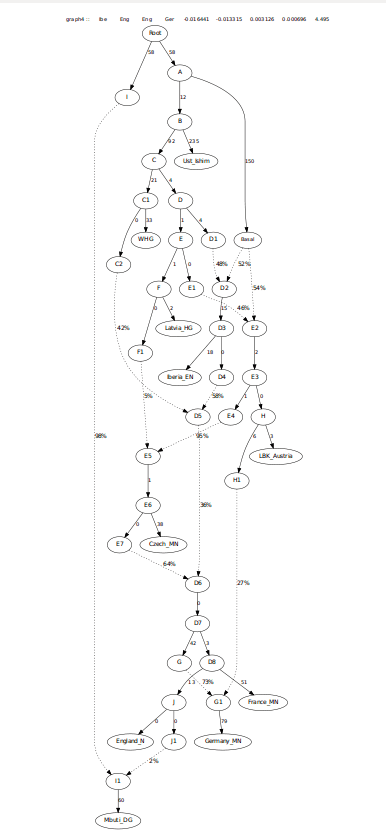
Melie Le Roy et al (2016)Distinct ancestries for similar funerary practices? A GIS analysiscomparing funerary, osteological and aDNA data from the Middle Neolithic necropolis Gurgy “Les Noisats” (Yonne, France) http://dx.doi.org/10.1016/j.jas.2016.07.003

Very interesting Chad.I know you’re busy, but the more you post, the better.
LikeLiked by 1 person
Thank you! I have another one in the works.
LikeLike
Chad, kudos. I remember debating this topic (Cardial vs Danubian in the megalithic sphere and shared ancestry across the megalithic sphere) with you before in the Eurogenes comments, where you were pretty adamant that the Globular Amphora Culture and Funnelbeaker was of solely Danubian inspiration, following archaeological evidence.
(To be fair my arguments to the reverse did not exactly have strong evidence in favour – as I recall Davidski’s Global 25 and other PCA, haplotype chunk sharing in present day and ancient peoples, shared D-stat behaviour between all northern MN like populations relative to other samples, possibly others).
So major props going back and being able to look at the evidence, reexamine assumptions and take a rigorous, formal look at the genetic evidence, carefully examine for possible inflators and biases in models, and revise your own ideas. Less people than we’d like can do that.
LikeLike
Thanks, Matt! I think my contention was that Globe25 had GAC as mostly Iberia EN or MN. They do come out more Danubian, but yeah the Western thing is a surprise. Use of Africans had a bad effect too, as shown in the post. Lots of things may need to be looked at again.
LikeLike
Thanks for the clarification, looking more carefully at your graphs I see what you mean. In retrospect, if I remember those conversations well, I possibly was not considering the full range of possibilities patterns of migration, and may have been overattached to mediating the genetic patterns through the idea of a specifically Cardial rooted migration both into and then *out* of Iberia, and that may have served to muddy the waters a little here.
LikeLike
Things change. I missed this earlier. I’m going to re-do everything where I had used Africans in graphs, to see what all changes.
LikeLike
I’m wondering if the odd affinity between Euro farmers and SSA shown in the D-stats table could be a reflection of some Upper Paleolithic gene flow from Iberia into the ancestors of Iberomaurusians, followed by IBM admixture into SSA? As the incoming Anatolian farmers move into Europe they would’ve picked up some remnant UP hunter-gatherer ancestry as well (I know WHG wasn’t a straightforward continuation of a UP Euro HG group but they should have had some ancestry ultimately stemming from such a pop, right?), perhaps causing some excess sharing between European Neolithic and SSA by way of the IBM conduit.
Also, the qpGraph with IBM below the aforementioned table is interesting, it has a sister branch of South African_HG leading directly to IBM. Prior to IBM, there was an apparently deep-rooted preceding culture in northwest Africa, the Aterian. In the original IBM paper, the authors found a signal of increased IBM affinity to east and south African HG pops to the exclusion of other Eurasians or Africans. I’m wondering if this graph is picking up on some admixture from an Aterian source into IBM.
LikeLike
Great work Chad, This and further elaboration will be of great use for specialists and enthusiasts interested in meating out Neolithic dynamics. There’s a lot more to be discerned after the arrival of Anatolian pioneer farmers to Europe.
LikeLike
I may have a little tweaking left. I’m trying a few more things.
LikeLike
BTW, cool Title 😉
LikeLike
My friend, Rob, came up with it. 🤣
LikeLike
Chad, not sure about the etiquette here re: external links, but can you take a look at this post I made on anthrogenica: https://anthrogenica.com/showthread.php?15415-Paleolithic-DNA-from-the-Caucasus-reveals-core-of-West-Eurasian-ancestry&p=497019&viewfull=1#post497019
I know this i just playing w/nMonte not formal stats but I think I picked up something here that I’m sure you’ll test when the Dzudzuana genotype sample is available: modern North Africans’ “Neolithic farmer” affinity ISN’T by and large from the more proximate (spatially and temporally) Europe_N/Chl/BA farming cultures but the more distal Dzudzuana source. (My theory is that Pelopponese_N_outlier is the closest proxy we have to Dzudzuana becuz:
a) it has more Villabruna affinity and less Basal Eurasian affinity relative to Anatolia_EN/Europe_EN, and
b) it’s Villabruna-like ancestry probably came from a more ‘easterly’ variant than the “WHG” substrate found in European farmers….
Dzudzuana should share these two distinguishing traits w/Pelopponese_outlier, relative to Europe_N/Chl/BA. The modern N African populations STRONGLY prefer a Dzudzuana-like source over Anatolia_N/Europe_N/Chl/BA type sources… this is telling us something IMO.
To the point in your post, I DO think Dzudzuana-like ancestry was quite widespread from N Africa down to at least the Sahel as early as the late Paleolithic (even modern Saharawi accept 25% Dzudzuana-like ancestry on top of that found in Iberomarusians– that can’t all come from Cardial Europe??). From there, it’s not too far gone to posit a push deeper into Africa.
As for why Iberomaursians don’t have “excess” Dzudzuana-related ancestry relative to modern N Africans, the northwestern pulse from Chalcolithic Iberia is plays a role but that’s accounted for separately and its less significant. The bigger reason reason Taforalt didn’t have excess Dzudzuana is b/c this ancestry infiltrated Africa in the Paleolithic from the NORTHEAST. This is consistent with the most “conservative” modern N African populations– Algerians, Mozabites, and Saharawi– scoring the highest peloponese_N_o and the most proximate pop to European farmers (Moroccans) scoring among the lowest. IOW, Pelopponese_N_o isn’t acting as a substitute for Iberian farmer ancestry, but as a substitute for the older Dzudzuana substrate.
Can you comment on the possibly apocryphal accounts of a population approximating a Sardinian-San 50/50 mixture surviving into medieval times in N Africa ?!?!
LikeLike
That Dzudzuana paper was interesting as well, the author’s main qpGraph appeared to show a Mota/African like population mixing into IBM. Chad, have you had any chance (or any interest) in trying to tease out some of the odd relationships between SSA, IBM, and Natufians lately?
LikeLike
Check out Lazaridis’ twitter, he links to a paper relevant to your post.
LikeLike
Thanks!
LikeLike
Chad, any ETA on a new post? Eurogenes is almost unreadable these days because of David’s pathological obsession with the immortal steppe and Indo-Europeans and Bell Beakers or whatever else. I appreciate your efforts to at least try to broaden the scope of discourse around population genetics, especially since it doesn’t seem like there are too many people out there getting in the weeds of this stuff with Admixtools (or whatever else) and doing their own analysis and investigations, outside of academia anyway…
LikeLike
I will get to the new Caucasus paper later on. I have a new one on European farmers, with lots of new information. Europeans are much more mixed than I had noticed before. Much different from the story at Barcin.
LikeLike
My next post should be up in the next few days. Making a lot of graphs and compiling stats now.
LikeLike